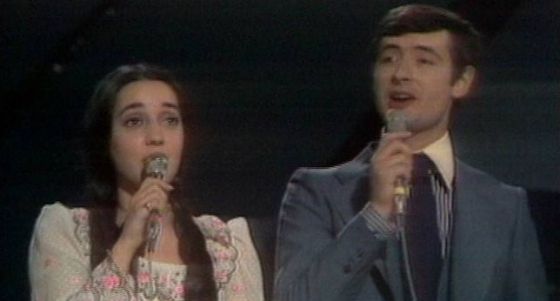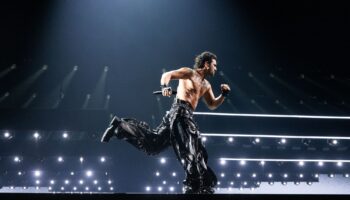The singer Sergio Blanco, who represented Spain in the 1975 Eurovision Song Contest with Estíbaliz Uranga, passed away on Sunday 15 February 2015 after a long fight against disease that had kept him from performing for the past years.
He was one of the founding members of the group Mocedades, but he would not be with them when they sang Eres tú for Spain in 1973. At that point he and his then fiancée Estíbaliz Uranga had taken their own way as Sergio y Estíbaliz, who would represent Spain two years later with Tú volverás.
Sergio Blanco had already spent a few years out of the spotlight due to persistent health problems. Unfortunately, it was announced last Sunday that the singer had passed away. His disease had won the fight, but it will not be able to wipe away the memory of the musician that left a footprint with Mocedades and Sergio y Estíbaliz in the memory of a whole generation of Spaniards.
Sergio Blanco was born in Bilbao, Spain in 1948. He completed his studies as an Engineer. It was in 1968 that he discovered and met the band Hermanas Uranga and its members, the sisters Amaya, Izaskun and Estíbaliz Uranga. It was during a charity recital that the band gave in the School of Engineering. The Sisters cultivated American folk, singing songs by Joan Baez or the Kingston Trio. After the recital Sergio approached the band, beginning a relationship that would lead to the foundation of the band Voces y guitarras with nine members, counting Izaskun, Estíbaliz and Amaya and Sergio. The group was the predecessor of Mocedades, which would be founded by Roberto Uranga.
Mocedades sang mostly songs composed by Juan Carlos Calderón. The band had eight members in 1969, the year when they stepped into the Spanish music stardome.
In December 1972 Sergio and Estíbaliz, who were in a relationship by then, decided to go their own way and and left Mocedades, The group would reach a second place for Spain in the Eurovision Song Contest the following year (1973).
Sergio y Estíbaliz were presented as a duo in the Sala Gwendoline in Bilbao in December 1973. They were well received by the public, who appreciated their songs Búscame, Volver or Piel.
They got married on 9 December 1974 in the Basilica de Nuestra Señora de Begoña in Bilbao.
The following year they represented Spain in the Eurovision Song Contest with Tú volverás. The result was discreet, but the song and the performance of the duo remain in the collective memory of the fans of the Eurovision Song Contest and the fans of the Spanish music of that decade, probably because of how much the song and the aesthetics of the performance are characteristic of those years. Something that a whole generation remembers with a twinge of nostalgia.
In 1976 Sergio y Estíbaliz recorded an album of popular Latin-American songs called Canciones Sudamericanas, which made them hugely famous in South-America.
In 1979 they participated in the show La misa campesina nicaragüense. That year they attempted to step into the English-speaking market with the album Beans, in English and with a completely different image. The album went practically unnoticed.
In 1983, after a break, they released the album Agua, which was a come-back to their original melodic style. The record was produced by Juan Carlos Calderón.
1984 and 1985 would be quite a productive period for Sergio and Estíbaliz: they performed together with the rest of Mocedades in the band’s 15th Anniversary Concert in 1984; they featured in the Spanish production of Jesus Christ Superstar; and in 1985 they released their album Cuidado con la noche, which included Cantinero de Cuba and Te quiero y ya. This was the album that took the duo to the top of the lists.
In 1988 they published Déjame vivir con alegría. De par en par (1989) and Planeta tierra (1992) were their two last albums. They were not well received by the public and the duo was dissolved and integrated with Amaya Uranga, Iñaki Uranga and Carlos Zubiaga to form the band El Consorcio, which would release 7 albums, the last one in 2008.
Sergio Blanco was not only a musician, but also a dedicated bronze sculptor. His pieces are mostly inspired in History, but he has also dedicated some sculptures to sportspeople and musicians. Many of his works are in art galleries, private collections and museums, such as the Madrid Naval Museum.
He has also completed statues that are set in public places, such as the Papa Luna in Peñíscola, King John II of Castile in Ciudad Real or the Duke of Ahumada in Madrid.
Sergio and Estíbaliz could be seen in 2007 as judges of a talent show of the Spanish broadcaster RTVE.
His health problems kept Sergio out of the stages for some years. He could be seen in October 2013 among the public of the Teatro Calderón in Madrid during a concert by El Consorcio dedicated to the memory of Juan Carlos Calderón. By then Sergio was sadly visibly deteriorated.
Sergio and Estíbaliz had two daughters: Allende (1983) and María (1988), who is also a singer.
It was Allende who communicated the passing of Sergio Blanco, an angel, in the words of his daughter. He died in the San Camilo Hospital in Tres Cantos at 6:30 CET on 15 February 2015. He was 66 years old.
We, the team of ESToday.com, wish to express our condolences to his daughter Allende and María Blanco and his widow Estíbaliz Uranga.
Sergio, you may have gone, but in the memory of many, now and forever, Tú volverás.
http://www.youtube.com/watch?v=jNSajQaIO_A





